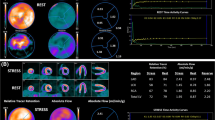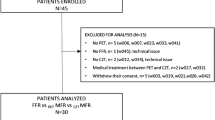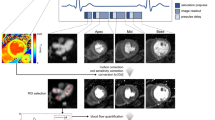Abstract
Purpose
We sought to evaluate the diagnostic performance for coronary artery disease (CAD) of myocardial blood flow (MBF) quantification with 18F-flurpiridaz PET using motion correction (MC) and residual activity correction (RAC).
Methods
In total, 231 patients undergoing same-day pharmacologic rest and stress 18F-flurpiridaz PET from Phase III Flurpiridaz trial (NCT01347710) were studied. Frame-by-frame MC was performed and RAC was accomplished by subtracting the rest residual counts from the dynamic stress polar maps. MBF and myocardial flow reserve (MFR) were derived with a two-compartment early kinetic model for the entire left ventricle (global), each coronary territory, and 17-segment. Global and minimal values of three territorial (minimal vessel) and segmental estimation (minimal segment) of stress MBF and MFR were evaluated in the prediction of CAD. MBF and MFR were evaluated with and without MC and RAC (1: no MC/no RAC, 2: no MC/RAC, 3: MC/RAC).
Results
The area-under the receiver operating characteristics curve (AUC [95% confidence interval]) of stress MBF with MC/RAC was higher for minimal segment (0.89 [0.85–0.94]) than for minimal vessel (0.86 [0.81–0.92], p = 0.03) or global estimation (0.81 [0.75–0.87], p < 0.0001). The AUC of MFR with MC/RAC was higher for minimal segment (0.87 [0.81–0.93]) than for minimal vessel (0.83 [0.76–0.90], p = 0.014) or global estimation (0.77 [0.69–0.84], p < 0.0001). The AUCs of minimal segment stress MBF and MFR with MC/RAC were higher compared to those with no MC/RAC (p < 0.001 for both) or no MC/no RAC (p < 0.0001 for both).
Conclusions
Minimal segment MBF or MFR estimation with MC and RAC improves the diagnostic performance for obstructive CAD compared to global assessment.







Similar content being viewed by others
Abbreviations
- AUC:
-
ARea under the receiver operating characteristic curve
- CAD:
-
Coronary artery disease
- CI:
-
Confidence interval
- ICA:
-
Invasive coronary angiogram
- IQR:
-
Interquartile range
- LAD:
-
Left anterior descending artery
- LCX:
-
Left circumflex
- LV:
-
Left ventricle
- MBF:
-
Myocardial blood flow
- MC:
-
Motion correction
- MFR:
-
Myocardial flow reserve
- MPI:
-
Myocardial perfusion imaging
- PET:
-
Positron emission tomography
- RAC:
-
Residual activity correction
- RCA:
-
Right coronary artery
- ROI:
-
Region of interest
References
Maddahi J, Czernin J, Lazewatsky J, Huang S-C, Dahlbom M, Schelbert H, et al. Phase I, First-in-Human Study of BMS747158, a novel 18F-labeled tracer for myocardial perfusion PET: dosimetry, biodistribution, safety, and imaging characteristics after a single injection at rest. J Nucl Med. 2011;52(9):1490–8. https://doi.org/10.2967/jnumed.111.092528.
Berman DS, Maddahi J, Tamarappoo BK, Czernin J, Taillefer R, Udelson JE, et al. Phase II safety and clinical comparison with single-photon emission computed tomography myocardial perfusion imaging for detection of coronary artery disease: flurpiridaz F 18 positron emission tomography. J Am Coll Cardiol. 2013;61:469–77.
Maddahi J, Lazewatsky J, Udelson JE, Berman DS, Beanlands RSB, Heller GV, et al. Phase-III clinical trial of fluorine-18 flurpiridaz positron emission tomography for evaluation of coronary artery disease. J Am Coll Cardiol. 2020;76:391–401.
Maddahi J, Bengel F, Czernin J, Crane P, Dahlbom M, Schelbert H, et al. Dosimetry, biodistribution, and safety of flurpiridaz F 18 in healthy subjects undergoing rest and exercise or pharmacological stress PET myocardial perfusion imaging. J Nucl Cardiol. 2019;26:2018–30.
Ziadi MC, Dekemp RA, Williams K, Guo A, Renaud JM, Chow BJW, et al. Does quantification of myocardial flow reserve using rubidium-82 positron emission tomography facilitate detection of multivessel coronary artery disease? J Nucl Cardiol. 2012;19:670–80.
Fiechter M, Ghadri JR, Gebhard C, Fuchs TA, Pazhenkottil AP, Nkoulou RN, et al. Diagnostic value of 13N-ammonia myocardial perfusion PET: added value of myocardial flow reserve. J Nucl Med. 2012;53:1230–4.
Joutsiniemi E, Saraste A, Pietilä M, Mäki M, Kajander S, Ukkonen H, et al. Absolute flow or myocardial flow reserve for the detection of significant coronary artery disease? Eur Heart J Cardiovasc Imaging. 2014;15:659–65.
Naya M, Murthy VL, Taqueti VR, Foster CR, Klein J, Garber M, et al. Preserved coronary flow reserve effectively excludes high-risk coronary artery disease on angiography. J Nucl Med. 2014;55:248–55.
Murthy VL, Naya M, Foster CR, Hainer J, Gaber M, Di Carli G, et al. Improved cardiac risk assessment with noninvasive measures of coronary flow reserve. Circulation. 2011;124:2215–24.
Moody JB, Poitrasson-Rivière A, Hagio T, Buckley C, Weinberg RL, Corbett JR, et al. Added value of myocardial blood flow using 18F-flurpiridaz PET to diagnose coronary artery disease: the flurpiridaz 301 trial. J Nucl Cardiol. 2020. https://doi.org/10.1007/s12350-020-02034-2.
Packard RRS, Huang S-C, Dahlbom M, Czernin J, Maddahi J. Absolute quantitation of myocardial blood flow in human subjects with or without myocardial ischemia using dynamic flurpiridaz F 18 PET. J Nucl Med. 2014;55:1438–44.
Calnon DA. Will 18F flurpiridaz replace 82rubidium as the most commonly used perfusion tracer for PET myocardial perfusion imaging? J Nucl Cardiol. 2019;26:2031–3.
Piccinelli M, Votaw JR, Garcia EV. Motion correction and its impact on absolute myocardial blood flow measures with PET. Curr Cardiol Rep. 2018;20:34.
Lee BC, Moody JB, Poitrasson-Rivière A, Melvin AC, Weinberg RL, Corbett JR, et al. Blood pool and tissue phase patient motion effects on 82rubidium PET myocardial blood flow quantification. J Nucl Cardiol. 2019;26:1918–29.
Kinahan PE, Townsend DW, Beyer T, Sashin D. Attenuation correction for a combined 3D PET/CT scanner. Med Phys. 1998;25:2046–53.
Nakazato R, Berman DS, Dey D, Le Meunier L, Hayes SW, Fermin JS, et al. Automated quantitative Rb-82 3D PET/CT myocardial perfusion imaging: normal limits and correlation with invasive coronary angiography. J Nucl Cardiol. 2012;19:265–76.
Slomka PJ, Alexanderson E, Jácome R, Jiménez M, Romero E, Meave A, et al. Comparison of clinical tools for measurements of regional stress and rest myocardial blood flow assessed with 13N-ammonia PET/CT. J Nucl Med. 2012;53:171–81.
Huisman MC, Higuchi T, Reder S, Nekolla SG, Poethko T, Wester H-J, et al. Initial characterization of an 18F-labeled myocardial perfusion tracer. J Nucl Med. 2008;49:630–6.
Efseaff M, Klein R, Ziadi MC, Beanlands RS, deKemp RA. Short-term repeatability of resting myocardial blood flow measurements using rubidium-82 PET imaging. J Nucl Cardiol. 2012;19:997–1006.
Vasquez AF, Johnson NP, Gould KL. Variation in quantitative myocardial perfusion due to arterial input selection. JACC Cardiovasc Imaging. 2013;6:559–68.
Cerqueira MD, Weissman NJ, Dilsizian V, Jacobs AK, Kaul S, Laskey WK, et al. Standardized myocardial segmentation and nomenclature for tomographic imaging of the heart. A statement for healthcare professionals from the Cardiac Imaging Committee of the Council on Clinical Cardiology of the American Heart Association. Int J Cardiovasc Imaging. 2002;18:539–42.
Nakazato R, Dey D, Alexánderson E, Meave A, Jiménez M, Romero E, et al. Automatic alignment of myocardial perfusion PET and 64-slice coronary CT angiography on hybrid PET/CT. J Nucl Cardiol. 2012;19:482–91.
Slomka PJ, Nishina H, Berman DS, Akincioglu C, Abidov A, Friedman JD, et al. Automated quantification of myocardial perfusion SPECT using simplified normal limits. J Nucl Cardiol. 2005;12:66–77.
Slomka PJ, Le Meunier L, Lazewatsky JL, Guido G, Berman DS. Multicenter development of normal perfusion and function limits for stress and rest flurpiridaz F-18 cardiac PET. J Nucl Cardiol. 2010;17:719–58.
DeLong ER, DeLong DM, Clarke-Pearson DL. Comparing the areas under two or more correlated receiver operating characteristic curves: a nonparametric approach. Biometrics. 1988;44:837–45.
Packard RRS, Cooke CD, Van Train KF, Votaw JR, Sayre JW, Lazewatsky JL, et al. Development, diagnostic performance, and interobserver agreement of a 18F-flurpiridaz PET automated perfusion quantitation system. J Nucl Cardiol. 2020. https://doi.org/10.1007/s12350-020-02335-6.
Hunter CRRN, Klein R, Beanlands RS, deKemp RA. Patient motion effects on the quantification of regional myocardial blood flow with dynamic PET imaging. Med Phys. 2016;43:1829.
Klein R, Hunter CRRN, Beanlands RS, DeKemp RA. Prevalence of patient motion in dynamic PET. J Nucl Med. 2011;52:2105
Koshino K, Watabe H, Enmi J, Hirano Y, Zeniya T, Hasegawa S, et al. Effects of patient movement on measurements of myocardial blood flow and viability in resting 15O-water PET studies. J Nucl Cardiol. 2012;19:524–33.
Naum A, Laaksonen MS, Tuunanen H, Oikonen V, Teräs M, Kemppainen J, et al. Motion detection and correction for dynamic (15)O-water myocardial perfusion PET studies. Eur J Nucl Med Mol Imaging. 2005;32:1378–83.
Koenders SS, van Dijk JD, Jager PL, Ottervanger JP, Slump CH, van Dalen JA. Impact of regadenoson-induced myocardial creep on dynamic Rubidium-82 PET myocardial blood flow quantification. J Nucl Cardiol. 2019;26:719–28.
Otaki Y, Lassen ML, Manabe O, Eisenberg E, Gransar H, Wang F, et al. Short-term repeatability of myocardial blood flow using 82Rb PET/CT: the effect of arterial input function position and motion correction. J Nucl Cardiol. 2021;28:1718–25.
Markousis-Mavrogenis G, Juárez-Orozco LE, Alexanderson E. Residual activity correction in quantitative myocardial perfusion 13N-ammonia PET imaging: a study in post-MI patients. Hellenic J Cardiol. 2017;58:245–9.
Author information
Authors and Affiliations
Contributions
Dr. Slomka conceived of the presented idea. Dr. Otaki developed the theory, performed imaging processing, statistical analysis, and wrote the manuscript. Dr. Slomka, Dr. Van Kriekinge, Mr. Wei, and Mr. Kavanagh developed the imaging software for this analysis. Ms. Singh and Mr. Parekh quality-checked the software. Drs. Di Carli, Maddahi, Sitek, Buckley, and Berman critically reviewed the manuscript. Drs. Slomka and Otaki to complete this work. All authors discussed the results and contributed to the final manuscript. The authors thank Cathleen Huang for additional data analysis and independent verification of the results.
Corresponding author
Ethics declarations
Conflict of interest
Dr. Berman, Dr. Slomka, and Mr. Paul Kavanagh participate in software royalties for QPET software at Cedars-Sinai Medical Center. Dr. Slomka has received research grant support from Siemens Medical Systems. Dr. Maddahi is Chair of the Publication Committee and a member of the Scientific Advisory Committee at GE Healthcare for the Flurpiridaz project. Dr. Berman has served as a consultant for GE Healthcare. Dr. Di Carli has received institutional research grant support from Spectrum Dynamics and Gilead Sciences.
Additional information
Publisher’s note
Springer Nature remains neutral with regard to jurisdictional claims in published maps and institutional affiliations.
This article is part of the Topical Collection on Cardiology
Supplementary Information
Below is the link to the electronic supplementary material.
Rights and permissions
About this article
Cite this article
Otaki, Y., Van Kriekinge, S.D., Wei, CC. et al. Improved myocardial blood flow estimation with residual activity correction and motion correction in 18F-flurpiridaz PET myocardial perfusion imaging. Eur J Nucl Med Mol Imaging 49, 1881–1893 (2022). https://doi.org/10.1007/s00259-021-05643-2
Received:
Accepted:
Published:
Issue Date:
DOI: https://doi.org/10.1007/s00259-021-05643-2




